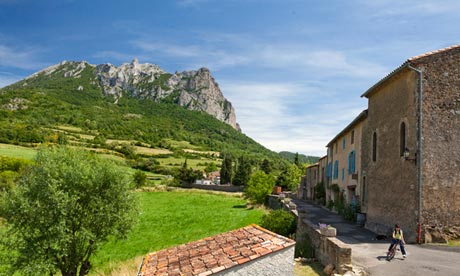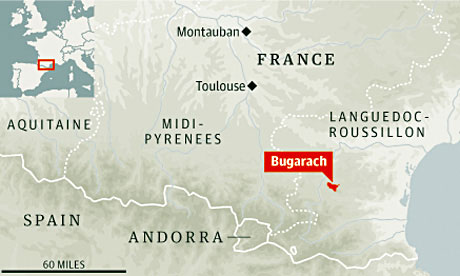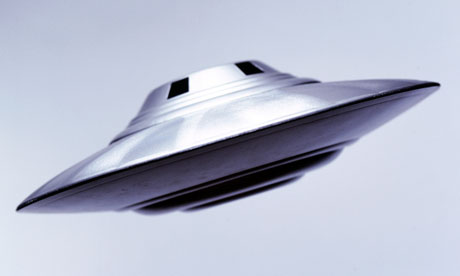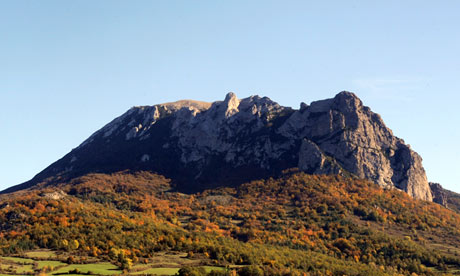
Bugarach … AKA 'the doomsday destination'. Photograph: Reuters
Bugarach, with its two narrow streets, 176 residents, little agriculture, scores of wild orchids and virtually no pollution, was barely heard of a few years ago. Now, it's arguably the most famous village in France, known variously as "the village at the end of the world", the "chosen village", or as CNN put it, "the doomsday destination".
According to a prophecy/internet rumour, which no one has ever quite got to the bottom of, an ancient Mayan calendar has predicted the end of the world will happen on the night of 21 December 2012, and only one place on earth will be saved: the sleepy village of Bugarach. The mayor, Jean-Pierre Delord, a farmer in his 60s, first spotted the apocalyptic forecast online two years ago after being alerted by a villager. He mentioned it at a council meeting, suggesting special security measures, perhaps army logistics, to handle an influx of visitors in December 2012. Someone at the meeting told the local press and before long world news agencies and Japanese TV crews were pacing the cobbles asking baffled villagers their views on armageddon.
 Bugarach, in the French Pyrenees. Photograph: guardian.co.uk
The French government's dedicated sect-watchdog, known as Miviludes, was soon on the case, keen to prevent any apocalyptic sect activity, or ritualised suicide by doomsday cults such as the Order of the Solar Temple,
which lost members in ritual killings in the Alps in 1995. French
government officials had spotted 2.5m websites referencing the Bugarach
end-of-the-world phenomenon by the end of 2010. These have now
mushroomed. Meanwhile, rumours of the impact on Bugarach got more
outlandish, helped by media that couldn't resist the saga of a rural
doomsday. Planes from America were said to have been fully booked for
December with passengers who had only bought one-way tickets, hippy
cults were claimed to have built bunkers beneath the village, and
half-naked ramblers were said to be seen wandering up the mountain in
procession, ringing bells. This turned out to be far from true. But as
D-day approaches, the rumour has created a heavy atmosphere among
villagers, who are keen for all of this – though not the world itself –
to end.
Bugarach, in the French Pyrenees. Photograph: guardian.co.uk
The French government's dedicated sect-watchdog, known as Miviludes, was soon on the case, keen to prevent any apocalyptic sect activity, or ritualised suicide by doomsday cults such as the Order of the Solar Temple,
which lost members in ritual killings in the Alps in 1995. French
government officials had spotted 2.5m websites referencing the Bugarach
end-of-the-world phenomenon by the end of 2010. These have now
mushroomed. Meanwhile, rumours of the impact on Bugarach got more
outlandish, helped by media that couldn't resist the saga of a rural
doomsday. Planes from America were said to have been fully booked for
December with passengers who had only bought one-way tickets, hippy
cults were claimed to have built bunkers beneath the village, and
half-naked ramblers were said to be seen wandering up the mountain in
procession, ringing bells. This turned out to be far from true. But as
D-day approaches, the rumour has created a heavy atmosphere among
villagers, who are keen for all of this – though not the world itself –
to end.At the tiny town hall, the leftwing, independent mayor of 36 years, Jean-Pierre Delord is dressed in jeans and wellies. "The Bugarach sign at the entrance to the village has been stolen for the third time – that costs a lot of money, you know," he sighs. Not to mention the pebbles taken from the mountain above the village and sold online as talismans, something he has filed a legal complaint about. Or the online sale of "prayers". There was even one idea by a budding entrepreneur to charge hopefuls five euros to send their last wills and testaments to Bugarach to be buried underground there for the end of the world, but it never happened
"The village has always attracted people with esoteric beliefs, they were here before and they will come afterwards, but this is something quite different," Delord says. This corner of southern France has long been a cauldron of mystic fables and occult conspiracy theories. Nearby Rennes-Le-Chateau, described in the Cadogan Guide as "the vortex of Da Vinci Code madness", is famous for its riddles of hidden treasure and a supposed cover-up of Jesus and Mary Magdalene's married life in France. All around is the countryside of the Cathars, the mysterious and persecuted medieval heretical sect, who have now inspired a local tourism drive. Nostradamus is said to have spent some of his childhood in nearby Alet-les-Bains.
But in Bugarach, says Delord, "it's all about the mountain". At 1,320m, the peak of Bugarach looms over the village. It sits alone, not part of a range, and some believe its spooky shape inspired the mountain in Steven Spielberg's Close Encounters of the Third Kind. Known as the "upside down mountain", it is a geological oddity whereby the lower layers of rock are mysteriously younger than those at the top. It is also host to a bewildering number of caves. Strange sounds from underground and odd light effects at the top have for decades seen the mountain likened not only to a UFO landing pad, but a "UFO underground car park", with regular spaceship vrooming and revving allegedly heard from within. UFO believers often travel here, looking for bits of spaceship amid the mountain rock. It has been claimed that the former French president François Mitterrand came here by helicopter to investigate.
 For decades, the village has been a source of UFO sightings. Photograph: Getty Images
Delord has no criticisms of anyone's beliefs about UFOs, or
otherwise, "It's a magnificent mountain and people say they do see
things – brilliance, lights, not necessarily extraterrestrials," though
he hopes aliens do exist somewhere in the universe. The number of
ramblers who have climbed the mountain has boomed since the apocalypse
prediction, from 10,000 in 2010 to 20,000 in 2011. Delord rejects
suggestions by some that he stoked the media frenzy himself. But does he
believe the world will end on 21 December? His eyes widen. "Of course
not. This is the 183rd end-of-the-world prophecy since antiquity. But I
can't take the risk of a lot of people coming here, trying to climb the
mountain and getting hurt." He wants the local authorities to shut off
mountain paths and control any crowds.
For decades, the village has been a source of UFO sightings. Photograph: Getty Images
Delord has no criticisms of anyone's beliefs about UFOs, or
otherwise, "It's a magnificent mountain and people say they do see
things – brilliance, lights, not necessarily extraterrestrials," though
he hopes aliens do exist somewhere in the universe. The number of
ramblers who have climbed the mountain has boomed since the apocalypse
prediction, from 10,000 in 2010 to 20,000 in 2011. Delord rejects
suggestions by some that he stoked the media frenzy himself. But does he
believe the world will end on 21 December? His eyes widen. "Of course
not. This is the 183rd end-of-the-world prophecy since antiquity. But I
can't take the risk of a lot of people coming here, trying to climb the
mountain and getting hurt." He wants the local authorities to shut off
mountain paths and control any crowds.In the organic shop on the edge of the village, a couple of civil servants from Nice were just down from the mountain top, enthusing about the weird sensations: how their compass went haywire, the strange cloud formations "in the shape of a wide-toothed comb". "There's an energy that's difficult to define but it does feel unique," says Corine Leblanc, who has lived here for several years. But suspicions and counter-theories abound about the apocalypse prophecy. Could it be designed to distract people from a real debate about whether wind turbines should be built in the village, some ask. Leblanc's partner, Patrice Etienne, worked in events management and communications in Paris for two decades and is sceptical. Could talk of the army closing off the mountain on 21 December in fact be cover for covert military operations and secret tests on paranormal activity? He's cynical about details such as fears that cult members might arrive here to end their lives. "Why come to the only place on earth that will be spared the apocalypse if you want to commit suicide? Wouldn't that be a bit like trying to drown yourself wearing a lifejacket?" he frowns.
"Is it that if you throw yourself off the mountain, then a spaceship would come by, scoop you up and save you?" wondered the owner of a guest-house in neighbouring Rennes-les-Bains, a spa-town known for its own esoterists, hippies and spiritualists, quick to add that she didn't believe for a second that Bugarach's mountain was an intergalactic Noah's ark. Normally, she would be shut for Christmas, but this year after a slow summer she had bookings for 21 December, so far mainly journalists.
The oddity is that tourist bookings this year seem to be down slightly, not up. The usual walkers, eco-tourists and people coming for spiritual retreats seemed put off by news crews doing lives-to-camera on armageddon. One Estonian rambler had taken refuge in Rennes-Le-Bain's thermal springs saying, "I went for one walk around Bugarach and was stopped by two TV crews asked if I'd prepared for the apocalypse."
In Bugarach, looking round the tiny church, Barbara Delahaye, a Spanish tourist in her 50s and a fervent Catholic, said there was no harm in all the fuss. "As Christians, one must always be prepared for the end of the world, it's not a bad thing to be kept aware of that."
Marco, an Italian warehouse worker from Genoa, had driven here to spend two days "looking for traces of UFOs" on the mountain. "I expected more people to be here," he says when he realises that he and a journalist are the only people at his guest-house that night.
In her restored terraced house, Valerie Austin, the local choir leader, summed up the odd atmosphere. "People come and look at us villagers as if we're all peculiar and in contact with some other world. I'm just waiting for one of them to give us a banana, I feel like a monkey at a zoo. We, the people that live here, have nothing to do with this," she says. Austin, a music teacher from Northumberland, moved here 24 years ago because "all the things I thought important in life seemed to be here: beautiful scenery, no pollution, clean water and kind of authentic, old-fashioned life-style."
She manages a holiday cottage that lost bookings over the summer because "people who wanted a quiet holiday were put off by the media buzz". The choir couldn't plan their usual pre-Christmas concerts in local villages because they weren't not sure whether there would be mayhem on the roads.
Does she believe any of it? "The Mayans couldn't even predict their own downfall, could they?" she sighs.
 Bugarach peak. Photograph: AFP
One of the most far-fetched claims has been of an apocalypse-inspired
property boom in Bugarach as people allegedly rushed to set up home
near safety. If prices have gone up in recent years, it has only been
part of the long-running general move of city-dwellers looking for the
rural dream. For-sale signs dot the village and neither sales nor prices
have soared. "Why would you buy a house if the world was about to end?"
asked one villager.
Bugarach peak. Photograph: AFP
One of the most far-fetched claims has been of an apocalypse-inspired
property boom in Bugarach as people allegedly rushed to set up home
near safety. If prices have gone up in recent years, it has only been
part of the long-running general move of city-dwellers looking for the
rural dream. For-sale signs dot the village and neither sales nor prices
have soared. "Why would you buy a house if the world was about to end?"
asked one villager.John Argles, a builder from London, was mid-construction on his dream house by the stream. An "atheist and a realist" he was surprised when he arrived that people asked him if he'd come for Doomsday. "That had nothing to do with it," he says. It was the nature, including its resident flock of vultures, that had tempted him. "It's the nearest thing to utopia I could find." He plans to meet friends for a celebratory drink in the local bar on 22 December.
Whatever its origins, the Bugarach prophecy has implanted itself in France's collective consciousness. Nicolas D'Estienne d'Orves, a novelist and opera critic for Le Figaro, released a book on it last week, The Village of the End of the World. A documentary on the life of villagers, The World Stops at Bugarach, will air on French TV, fittingly, on 20 December. D'Estienne d'Orves says it was "impossible" to get to the bottom of the genesis of the Mayan Bugarach rumour. "It was grabbed on to because this is a place where there's nothing, so you can easily project your fantasies on to it. It's like filling a balloon with air," he says. His book includes the letters received by Bugarach's mayor over the past two years of apocalypse frenzy, including one well-wisher proposing to organise "The Bugarach music festival: a new world beginning for humanity" to coincide with the end of the world, in which he promised to get together Peter Gabriel, Pink Floyd, Paul McCartney, Paul Simon, Led Zeppelin, Jean Michel Jarre and the Black Eyed Peas.
The French government, however, is obliged to take it seriously. More than 700km away in his Paris office near the prime minister's residence, Serge Blisko, head of Miviludes, says he would be advising local authorities on how to prepare policing and keep an eye for gurus and sects exploiting people. "After these moments, there can be a danger of psychological collapse. If fragile, vulnerable people expect an event like the end of the world and it doesn't happen, they can feel let down and in anguish," he says.
Meanwhile, on sale in the village is wine called "Cuvée Bugarach" labelled: "If there's only one left, I shall be that one." It helps "communicate with extra-terrestrials", the blurb says.
Over the next weeks, the state will decide what level of security is needed in the village on 21 December, whether to close mountain paths and how to handle any visitors. Although if it's snowing and icy, it would be almost impossible to access it by car via the death-defying canyon bends of the nearby Gorges of Galamus.
At the town hall, the mayor, while hoping the fuss would soon be over, was still proud of his village's fame. "If I'd have have had to pay a communications agency for this kind of publicity, it would have been a fortune," he says.
